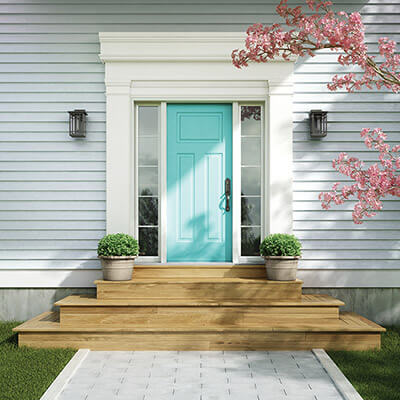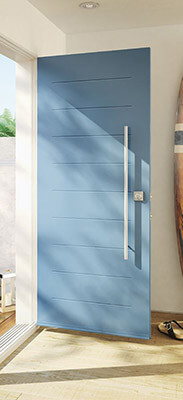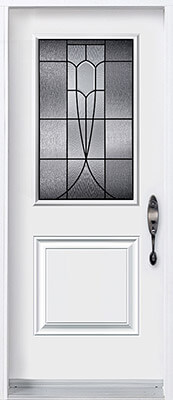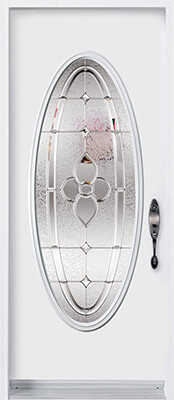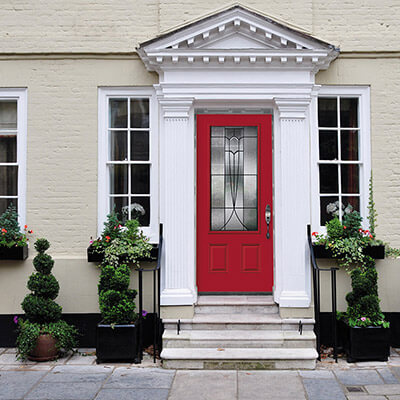Nothing can change the look of your home more dramatically AND cost effectively than a new entry door. If you’re looking to enhance the curb appeal of your home, a new front door is a great place to start. This guide will help you understand what to look for in a new custom entry door and will highlight recent trends taking shape in the industry.
The Right Type of Door for your Home
Wooden doors have been around for thousands of years and are still a great option if you’re looking to create a unique style for your home. In recent years, advances in materials and fabrication have caused steel and fiberglass doors to become the material of choice for most replacement doors. Here’s what you should consider when choosing between door materials:
Steel Doors
Steel doors are the most common type of entry doors sold today because of their inherent strength, durability and cost efficiency. Steel doors are made from heavy gauge galvanized steel (coated with zinc to prevent rusting) that is resistant to warping, shrinking or swelling. Steel doors are built with a solid polyurethane foam core that provides superior insulation qualities.
New metal stamping and embossing techniques now allow for steel doors to be made into a variety of stamped shapes and patterns. Steel doors can even be made to approximate a woodgrain pattern.
While steel is durable and very strong, it is more vulnerable to scratches and dents than fiberglass doors.
Steel Door Examples
Fibreglass Doors
Like steel doors, fiberglass exterior doors won’t split or delaminate. Fiberglass offers an extra advantage over steel in that fiberglass can easily be fabricated into a wide variety of shapes and textures. This makes Fiberglass particularly suitable for use in new design treatments. Fiberglass can also be made to closely mimic a natural wood grain.
Like Steel Doors, Fiberglass entry doors are suitable for our extreme northern climate and require little to no maintenance. Fiberglass doors are also built with an energy efficient polyurethane solid core interior that provides similar insulation values to that of Steel Doors.
Fibreglass Door Examples
Fiberglass doors are typically more expensive than steel doors and while they are more scratch and dent resistant than steel doors they could crack if a significant force is applied to the face of the door.
Wooden Doors
There’s no denying the natural beauty of a wooden door - but that beauty usually comes at a cost. Wooden doors are typically much more expensive than steel or fiberglass doors. Because wooden doors are made from natural materials they must be maintained on a regular basis to prevent stripping and fading, and wooden doors are also more prone to warping, splitting or cracking over time. Wooden doors are also susceptible to natural concerns such as mold and mites.
Most wooden doors today benefit from improved fabrication techniques that make them far more resistant to warping from humidity and temperature changes.
Wooden doors can range significantly in price between inexpensive composite materials and high-end exotics and hardwoods.
Wood Door Examples
Buyer's Tip #1
Your warranty is the most important part of your front door purchase.
The company who sells you your door can make any type of claim about the “quality” of their door. Those claims don’t matter. Your warranty isn’t a claim – it’s a guarantee, and that’s what really matters.
Doors get a lot of use and abuse. You need a warranty that guarantees:
- Your door will function properly for a long time and
- The quality of the installation (not just the door itself) and
- Any maintenance or service that might be needed over that same long period.
A promise of “Superior Craftsmanship” or a vague reference to a “Lifetime warranty” is useless to homeowners if those promises, and that warranty, does not guarantee all parts and installation and service for the reasonable life of your door. The reasonable life of your door should at least 20 years. (Offering a “Lifetime” guarantee on the glass in your door – as an example - provides little value to the homeowner.)
2018 Trends in Entry Doors
“Windows open out into the worlds that we inhabit while doors open into the world that we create.”
Here are some of the trends taking shape in the industry:
More glass in the front door
New construction homes used to come with doors consisting of basic wooden door slabs and one or two simple sidelights. The trend in the past was to replace these old doors with something similar – perhaps with a ¼ lite panel at the top of the door to allow more light in but still to ‘maintain privacy’ in the front entranceway. That’s all changed in the last few years.
We’re now seeing more and more of our customers ordering a ¾ lite panel or full lite panel of glass in their entry doors. The reason? To bring more light into the home and to improve the curb appeal of the house.
Not only does adding glass panels increase natural light in the entranceway it also provides the homeowner with a new canvas to express themselves. New glass panel shapes, designs and configurations can now be created in an almost infinite number of combinations.
More colour choices and bolder colours
You used to pick your front door colour to match the colour of your garage or to complement the colour of the siding of your home. The intent was to blend the door in with the overall colour scheme of the home.
Now we’re seeing doors being used as a stand-alone accent to introduce a ‘shock of colour’ to an otherwise subdued visual exterior presentation. Almost any conceivable colour is possible and for some – the bolder, the better.
Cleaner, simpler European styles
Traditional door designs emphasize raised or inset panel features and employ more intricate glass treatments that suit the door panel style. Beveled edges and curves are the norm. While this traditional style of door is still in demand we’re seeing a lot of customers begin to make choices that reflect a cleaner, simpler aesthetic. Shaker style doors, flat panels, flush surfaces, simple geometrics and clean lines are dominating new modern door design.
Glass panels are following suit as well. Busy glass panels with organic shapes, multiple textures, and intricate trellis and muntin designs are now being replaced by simple geometric shapes and textures.
Buyer's Tip #2
Proper Installation is the key to energy efficiency and the longevity of your door.
Most new doors have high ENERGY STAR ratings and the difference between door materials in terms of energy savings is quite small. What can make a big difference is the quality of the installation work done for your new door. To operate at maximum efficiency your new door must be installed properly which should include:
- A thorough inspection of the structural opening prior to installation.
- Factory-trained career installers (not temps or general contractors) performing the work.
- Use of only top quality, factory-approved installation materials and supplies such as specialized caulking, low E. foam. latex, trim and fasteners.
Front doors are getting bigger
The average replacement door width (width of the door opening) is 34”. Other common widths are 32” and 36”. The width of doors is increasing for several reasons:
- The extra width is more practical. If you’ve ever tried to move a wide couch through a narrow front door entranceway, you’ll appreciate the extra room to maneuver that a wider door provides.
- Larger doors make a larger statement. A wider door makes your entranceway feel larger and it has a bigger influence on the overall look of your home.
- Larger doors allow more light into your home. With the trend to more glass in doors, larger doors also mean more light in your entranceway.
Asymmetry in design
We’re seeing a trend away from convention in door design today. Traditional door design typically incorporates a visual balance created by uniform spacing and equal weight to all design elements.
Modern door design is beginning to move in the opposite direction – to embrace imbalance and asymmetry. Door rails and stiles are not the same width, glass is not placed in the center of the door and the door glass itself contains its own unique geometry and character.
Having moved through the ‘Renaissance era’ of 1970’s and 80’s traditional door construction and styles we are now at the beginning of a new ‘Modernist movement’ in door design.
Buyer's Tip #3
All door frames are not created equal.
A solid, properly built and installed door frame is integral to the proper function of your front door. At the risk of getting too geeky with ‘window tech’ here are some of the main areas where door frame construction can make a big difference:
- Thicker wood frames (i.e. 1 ½ or 1 ¾ inch wood frames) will perform much better than the industry standard of ¾ inch or 1-inch frames).
- Solid door sills are far superior, but they are not standard. They should be. Hollow chamber door sills will allow water infiltration that could damage your door over time.
- All door hinges should be anchored to a steel plate on the exterior of the frame. This gives the door more strength. This is not the industry standard.
- Your door should contain multiple air seals – not just one – to ensure maximum performance of your door.
Choose Your Door in 5 Easy Steps
There are literally thousands of possible permutations for you to consider when selecting a new entry door that include different styles, configuration, glass, colour, size and hardware. There’s a lot of information to consider when selecting your new front door. We’ve tried to make this process easier by summarizing (and simplifying) the important things you need to consider when choosing your new entry door:
Configuration
Are you looking to replace what you currently have or to do something different? Most replacement door projects are simply replacing what is currently in the house. (I.e. “I need to replace our 32” door that has two 12-inch sidelights with the same configuration.”)
Depending on the size of the door opening there are many possibilities available to you. You may have enough room to add a sidelight or a transom. You might want to reconfigure your double doors to a wider single door with two sidelights (which is quite common today) … or visa, versa. Your door consultant will be able to provide you with the best options given the size of your entire door opening. Enlarging the door opening area is also a consideration if the structure of your home allows it.
Door Configuration Examples
Style
Are you looking for a modern design or a traditional design? This question helps narrow down the scope of possibilities and allows your door expert to provide more specific advice. The earlier in the process you can indicate that you are “looking for something like this,” the better. This first step provides valuable context to move your decision-making forward.
Traditional Door Styles
Modern Door Styles
Glass
Given the style you have chosen, what size and configuration of glass are you looking for? This is where an experienced door expert can provide a tremendous amount of value. There are hundreds of styles sizes and types of glass that you can consider for your entry door and a good door expert will advise as to which styles work together, information on what others are buying today and what to consider for each different combination of glass and door styles.
This is typically the most challenging AND the most interesting part of the door selection process!
Various Glass Options and Configurations
Buyer's Tip #4
Buy Canadian, Buy local.
Aside from the obvious patriotic benefits of supporting local manufacturers there are also very practical benefits to buying from a company that you know is local. If you ever need service or parts for your door, for whatever reason, it’s important to have a strong warranty in place to cover any issues that may arise AND it’s also important to have a local company to be able to immediately service your door. Buying a door from someone that does not have a long history in your area might lead to issues if ever service or parts are required for your new door.
Colour
How bold do you want to go? This decision used to be the easiest to make – did you want light beige, dark beige or brownish? Today, picking door colours is as challenging as picking wall and accent colours for your new renovation. There are no wrong colours! (In truth there are… but… we don’t judge.)
Colour your world!
Examples of traditional and bold colours
Hardware
What do I select as the finishing touch for my door? Door locks and handsets are chosen to compliment the design of your door. If you’ve selected a modern look then you’ll want a contemporary style lock and handset to match. There are many colours, shapes and finishes available for door hardware. Your door expert will help you make the right choice.
Examples of Weiser handlesets and smart locks in various styles and finishes
… now the only thing left to do is book your installation date!

